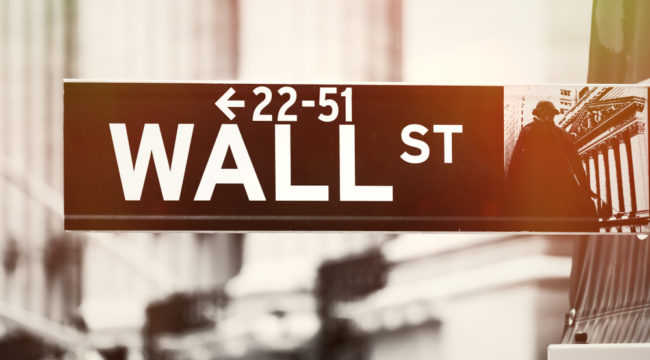What Now?
The long, dark night of the soul has ended… and joy is once again upon the land.
Up 251 points yesterday, the Dow Jones set its first record high since February’s “correction.”
The usual rah-rah men were in full blast.
Even the president marked the occasion with a celebratory felicitation:
“Congratulations USA!”
Apple, Caterpillar and Boeing led the way yesterday — all trade-sensitive stocks.
But wait.
Did not the administration impose tariffs on $200 billion of Chinese goods just this Monday?
And did not China immediately announce retaliatory imposts on $60 billion of American goods?
Yes, both are true.
So explain Apple, Caterpillar and Boeing, you demand.
The answer widely on tap is that markets had pre-digested the trade news… and already factored in the blows.
Markets enjoy seeing their expectations confirmed, providing the news is no worse than envisioned.
The known devil may be a devil — but at least he is known.
By the logic here described, markets would have gone to pieces if the tariffs were waved off altogether.
But let it go.
A single question hangs in the air today:
What next?
Let us cast a wry squint into the future… and steal a glance of events to come…
We have written before of a “melt-up.”
The melt-up being that terminal, incandescent phase of bull markets that lifts stocks to ridiculous extremes — before burning up.
Greed is high in the saddle… as investors leave all fear behind.
Mark Hulbert is a financial analyst and former editor of the eponymous Hulbert Financial Digest.
According to Mr. Hulbert, stocks have now surmounted the “wall of worry” that stood through early August.
The Hulbert Nasdaq Newsletter Sentiment Index — a barometer of greed — registered negative 2.7% at the time.
But its most recent reading rings in at 70.1%… nearly identical to the 70.6% reading immediately preceding January’s market high.
His conclusion:
“The mood on Wall Street has shifted from fear to greed.”
Hulbert is not alone…
Citi’s “Panic/Euphoria” model reveals that markets have now crossed the euphoric threshold.
Mark Hackett, chief of investment research at Nationwide, explains the herd psychology:
“When it’s confirmed you’re at new highs, people see that as an all-clear signal and they jump in.”
But is the herd jumping into a trap?
We suspect markets may be laughing off the trade war prematurely.
Just yesterday Trump declared, “It’s time to take a stand on China. We have no choice…”
Will China accept the president’s verdict?
We are far from convinced.
Nor is Mr. Dec Mullarkey, managing director of investment strategy at Sun Life Investment Management:
I think both countries are on a collision course and that’s not going to get resolved quickly, and I think we’re heading toward all China imports getting hit with tariffs.
When the world’s two largest economies lock horns in battle, can markets escape unscratched?
“If it gets worse,” warns Lorenzo Bini Smaghi, chairman of SocGen. “The whole world economy is going to slow down.”
Meantime, the Federal Reserve will likely raise interest rates next week and again in December.
As we explained recently, December’s rate hike will take the fed funds rate above the “neutral” rate.
Since the 1990s, trouble was on tap whenever the fed funds rate (blue) crossed the neutral rate (red):

But our agents inform us that central banks around the world over are getting in on the business.
In fact, combined total global rate hikes are nearing the number that immediately preceded the great financial crisis.
“Given this tightening,” explains the Financial Times, “global liquidity has contracted quite substantially.”
All the while the Federal Reserve is tucking into its balance sheet.
Total reductions this year may exceed $400 billion. Next year’s reductions are projected at a thumping $600 billion.
Thus a great deal of market-supporting liquidity is oozing from the system… like pus from a giant boil.
But markets seem unaware, blissfully unaware…
As we also reported recently, the Goldman Sachs “Bull/Bear Market Risk Indicator” is giving 75% odds of an impending bear market.
Not since 1969 has it recorded such heightened levels — and such heightened risk.
In fact, lower readings than today’s preceded both the 2000 and 2008 bear markets:

“The stock market resembles a drunk at the top of a hill,” cautions Bernard Baumohl, chief global economist at the Economic Outlook Group.
“He’s wobbling and you know that drunk’s going to fall but you just don’t know when or how hard,” he continues.
Here we switch metaphors, while keeping to the theme of a fall…
In the old Road Runner cartoons, the cagy roadrunner would lead Mr. Wile E. Coyote, in hard pursuit, to the edge of the cliff.
The roadrunner would stop.
But the fixated coyote would keep going, unaware of the peril awaiting.
The poor fellow defied gravity for several seconds… until a downward glance forced a harsh reappraisal of facts.
Horrified, down he went, 32 feet per second, before impacting the ground below.
We cannot say at this time if markets are on the verge of a melt-up — which could lead to a “Wile E. Coyote moment.”
But like the hapless coyote, investors may look down one day to discover there’s nothing holding them up.
In the cartoon the coyote invariably walks away from his death plunge, only slightly worse for wear.
Unfortunately for investors, life is not a cartoon…
Regards,
Brian Maher
Managing editor, The Daily Reckoning



Comments: